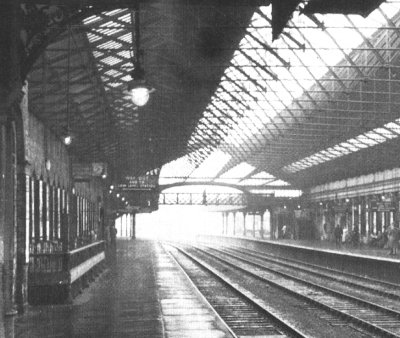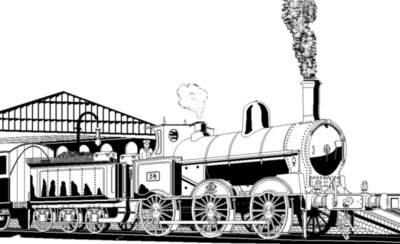 |
Rails In Wolverhampton - The Early Years
by Bev Parker |
 |
|
Wolverhampton like many of its neighbours benefited greatly from the
arrival of the
railways. Most of these arrivals were stormy affairs due to the intense
rivalries and
mistrust that existed between individual companies, which often involved a
lot of
legal wrangling. Wolverhampton was different to most towns because these
rivalries got completely out of hand and resulted in a couple of battles
taking place
between rival companies. One of the most important dates in the early years
was
3rd August 1846 when several important railway Bills were passed in
Parliament,
which allowed the construction of the majority of the local lines. |

The map shows the early railways around the town centre.
Click on the buildings or text for more information
| The first railway to reach Wolverhampton was the
Grand Junction Railway which
opened on 4th July 1837. Its station was situated at Heath Town behind
the
modern Culwell Industrial Estate, off Woden Road. It was called "Wednesfield Heath for Wolverhampton" station, and was about
a mile from the town centre.
It was a first class station which meant that all trains stopped there. The
company
made no attempt to gain access to the centre of Wolverhampton itself,
presumably
because of the high cost involved. The station's opening caused much concern
amongst the local canal companies who feared that their extensive trade
could be
threatened, but at this time they had nothing to fear because the initial
goods
services were both limited and expensive.
An intensive coach and omnibus service developed to
take passengers to and from
the town centre. Two coaches also acted as shuttles to ferry people to
coaching
inns such as the Swan on High Green, for connections to Worcester,
Shrewsbury,
Bridgnorth, and Stourbridge. Initially there were six trains daily in each
direction,
but the station was never popular being so far from the town centre. Access
to the
station was dirty, and often covered in sewage. One of the adjacent fields
was
used for the dumping of night soil, which was the waste from open toilets,
and so
the whole area was very smelly and unpleasant.
After a year or so the
railway
company tried to increase the number of passengers using the station by
improving
the facilities. They also pioneered the use of low fares, which were
introduced from
August 1841 on the racing trains that brought people to Wolverhampton races.
In
1842 the station became a special low fare station with first class travel
costing two
pence a mile.
|
|

A Grand Junction Railway train. |
|
|
| The second station in Wolverhampton was situated in
the town centre but was
only a temporary affair. It was situated on Wednesfield Road, in-between the
railway embankment and what is now Broad Street canal basin. It was built by
the Shrewsbury and Birmingham Railway who intended to run their trains into
the High Level station, which at that time was not built. The Shrewsbury & Birmingham formed an alliance with
the London &
Birmingham Railway who offered them a lease. The London & Birmingham
saw the Shrewsbury & Birmingham as an alternative route to the north, which
interested them because they distrusted the Grand Junction Railway who at
that
time had a monopoly on the route. By the time the Shrewsbury & Birmingham's Bill had
passed through Parliament
the London & Birmingham had joined forces with the Grand Junction to form
the London & North Western Railway. They in turn were keeping a wary eye
on the Great Western Railway who were perceived as a potential threat and
were fast approaching Wolverhampton via the Birmingham & Oxford Railway,
and the Birmingham, Wolverhampton & Dudley Railway.
The Shrewsbury & Birmingham's Bill gave them a half
share in the High Level
station, and when the temporary station was built they assumed that all was
going according to plan. Things soon started to go wrong as the London &
North Western quickly gained control of the Stour Valley Line, and then
decided to lease the Shropshire Union Railway, which shared the first ten
miles
of the Shrewsbury & Birmingham's line. Initially this was opposed by the
Shrewsbury & Birmingham but they soon gave in when the London & North
Western offered them a traffic agreement in return for running powers over
the
Stour Valley Line, which would finally give them access to Birmingham. The
agreement was ratified by an Act of Parliament in July 1847. |
|

Old Wolverhampton High Level
Station. |
The temporary station opened on 12th November 1849,
but the relationship
between the Shrewsbury & Birmingham, and the London & North Western
soon became problematic. The latter decided to reduce its fares on the
Shropshire Union line from Stafford to Shrewsbury, so ignoring the
1847
agreement.
The Shrewsbury & Birmingham immediately sought, and got an
injunction to prevent this practice, but the London & North Western
successfully opposed it. A long legal battle and a price war commenced.
The
London & North Western retaliated by further delaying the opening of the
Stour Valley Line. |
| The Shrewsbury and Birmingham was getting
increasingly frustrated because it
still couldn't send its freight to Birmingham by train, and so it decided on
a
different approach. The Birmingham Canal ran alongside the track, and was
seen as a convenient alternative. Work started on a canal wharf in April
1850.
On Friday 12th July a group of workmen were fitting an access gate into the
boundary fence when the London & North Western decided to stop them. Mr.
Moore who was one of the Stour Valley's contractors sent a gang of men to
halt
the work. An argument followed between Mr. Moore and the Shrewsbury &
Birmingham's engineer, Henry Robertson. Soon some 300 Stour Valley
workmen, all armed with spades, pick axes or the tools of their trade
descended
on the scene to halt the work once and for all. They were soon followed by a
Shrewsbury & Birmingham train which brought about 200 men to the scene, also
similarly armed, and distinguished by arm bands made of red tape. Soon
fighting
began, and the Mayor, who summoned the police and army, read the Riot Act.
The two factions were separated, and another series of legal battles began.
The London & North Western were now even more
determined to delay the
opening of the Stour Valley Line, and if possible prevent the Shrewsbury &
Birmingham from using it. Angered by these tactics the Shrewsbury &
Birmingham signed a traffic agreement with the Great Western Railway on 10th
January 1851, which led to an offer to amalgamate in 1856 or 57. The London
&
North Western got to hear of this and decided that the Shrewsbury &
Birmingham
were in breach of their 1847 agreement, and so had lost their right to run
on the
Stour Valley Line.
|
The Stour Valley Line was completed on 21st
November 1851, and the official
opening was to be on the 1st December. The Shrewsbury & Birmingham was
determined to start and run its trains on the line from that date, and
openly
advertised the fact. On the fateful day, word that there might be trouble
quickly
got around, and a crowd of several thousand spectators arrived at Queen
Street
station to see the events. The Mayor was asked to attend, and as trouble was
expected he summoned the local police, and the army.
|

A London
and North Western "Cauliflower" at the High Level. |
| The train from Shrewsbury arrived at 9 o'clock and
started to Birmingham about
fifteen minutes later. As the locomotive departed the crowd cheered and all
looked well. A number of detonators had been placed at the beginning of the
Stour Valley track, and these were ignored. The locomotive was quickly
brought
to a halt however when it reached a London & North Western locomotive called
Swift, and a brake-van, both of which were placed in its path. It attempted
to
push the North Western train out of the way but failed because its brakes
were
screwed hard down. The North Western driver was asked to clear the
obstruction
but was ordered to do no such thing by the company engineer. Swift was
guarded
by 100 men, and about a quarter of a mile further along the track a
locomotive was
derailed, and several lengths of rail were taken up to make it look as if
the line had
been closed because of an accident. The matter immediately proceeded to the local
Magistrate's Court, where the
Shrewsbury & Birmingham case was based on obstruction. The magistrate urged
both parties to find a peaceful solution, and to avoid committing a breach
of the
peace. The London & North Western delaying tactics continued to work until a
court order forced them to open the line. The line eventually opened on 1st
February 1852, but for London & North Western goods only. On 1st July the
line
opened for London & North Western passenger services, and in a further
attempt
to keep the Shrewsbury & Birmingham at bay, they started a half hourly
service on
1st May 1853, claiming that it would be dangerous to have any other trains
running
at the same time.
The Shrewsbury & Birmingham finally accepted an
arbitration award that fixed a
high rent for its use of New Street station, and it started running trains
there from
4th February 1854. The London & North Western never allowed through
ticketing for Shrewsbury & Birmingham trains, and no connections were made.
While this was going on the Great Western lines
were rapidly approaching
Wolverhampton, the first one opened on 1st July. As the Shrewsbury &
Birmingham had been greatly weakened by its fight with the London & North
Western it brought its amalgamation with the Great Western forward to 1st
September. It was granted an extension to its running powers on the StourValley Line because of a collapsed bridge on the Great Western line between
Soho and Handsworth stations. Its trains moved to the Low Level station
when the GWR line to Birmingham opened on 14th November 1854.
Conclusion
This has been a very much simplified description of
the early railway years at
Wolverhampton. The legal battles between the different companies were
extremely
complex and a complete description of these would require far more
space than is
available here. This was also a suitable time to end because by the mid
1850's all
of the major lines were in place, the only important features missing were
the
building of the Great Western Locomotive works at the Stafford Road site
in 1859, and the opening of the Midland Railway's line on 1st November 1872.
Bibliography
|
Rex Christiansen. |
A
Regional History of the Railways of Great Britain
Volume 7. The West Midlands. |
ISBN 0 946537
00 3 |
| Rex
Christiansen. |
Forgotten
Railways: Vol. 10. The West Midlands. |
ISBN 0 946537 01 1 |
| Rex
Christiansen. |
Rail Centres:
Crewe. |
ISBN 0 7110 2148 1 |
| Richard K. Morriss. |
Rail Centres:
Shrewsbury |
ISBN 0 7110 1571 6 |
| Paul Collins. |
Rail Centres:
Wolverhampton. |
ISBN 0 7110 1892 8 |
| Paul Collins. |
Britain's Rail
Super Centres: Birmingham. |
ISBN 0 7110 2005 1 |
| Geoffrey Body. |
Great Railway
Battles. |
ISBN 1 85794 033 4 |
 |
Return
to the
Exhibition |
|
|